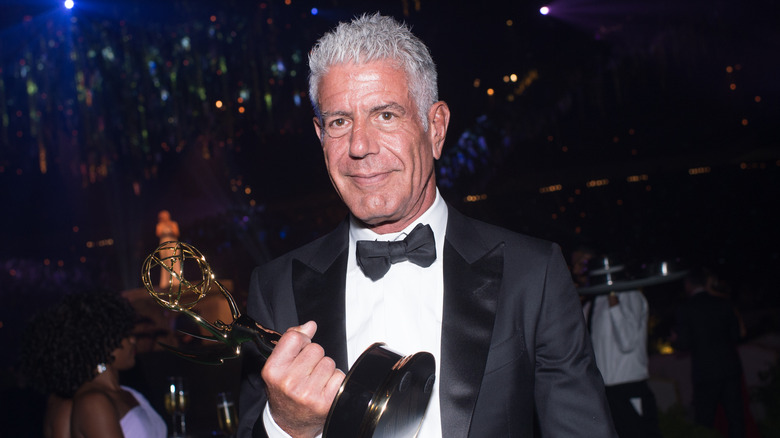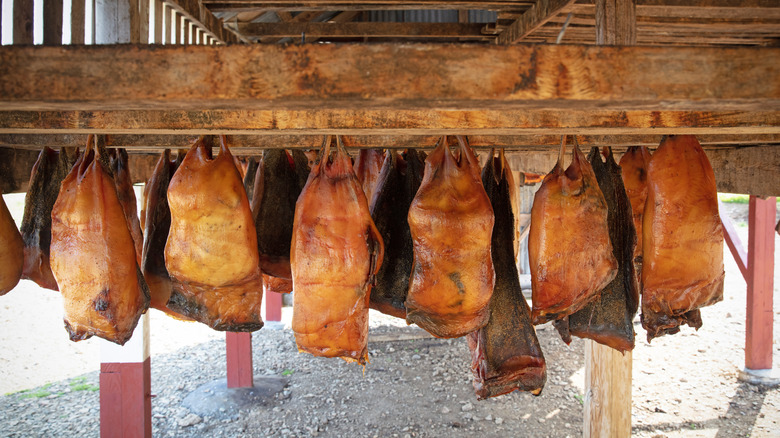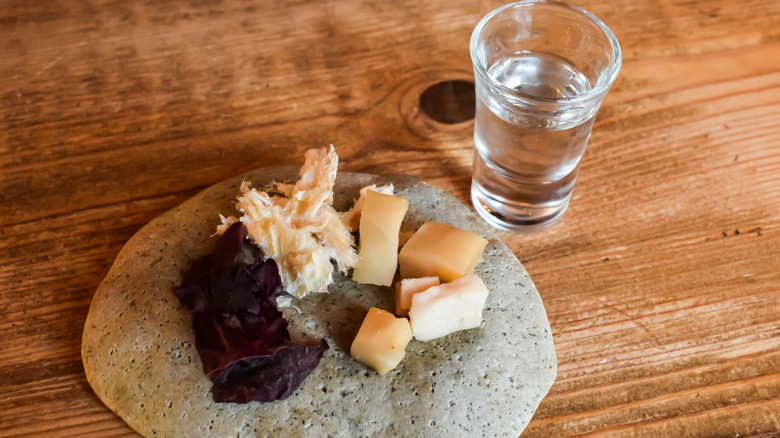The Meat Anthony Bourdain Refused To Ever Eat Again
Anthony Bourdain was not afraid to try even the most disturbing-looking, smelling, even still-beating foods (he famously once ate a still-beating cobra heart). In fact, he was known for his eagerness to fully immerse himself in unfamiliar cultures by sampling what many tourists would consider sketchy dishes. Many times, he was pleasantly surprised upon tasting something that initially may have given him the creeps, but this wasn't the case when he ate fermented shark meat.
Hákarl is an Icelandic delicacy that is commonly served during a mid-winter heritage festival called Þorrablót. The foods served during the festivities tend to honor early preservation practices that ancestral Vikings would have used for their foods. Hákarl is made from the Greenland shark, whose meat is poisonous when fresh, hence the need to ferment it in order for it to be edible. Traditionally, the meat was buried, and it essentially rotted and released its toxins for two months before it was unearthed and hung to dry for another four months. Today, burial is optional, but either way, the brown, leather-like skin that develops on the meat has to be removed before it's eaten. Getting past the smell is the first hurdle, though, as hákarl exudes a robust ammonia odor, which many claim is a lot stronger than the actual flavor.
Bourdain didn't mince words
During the episode of "No Reservations" in which Anthony Bourdain sampled hákarl, he described it as "unspeakably nasty ... probably the single worst thing I've ever put in my mouth." That, indeed, is a mouthful coming from a man who also had the pleasure of eating warthog anus (hated it), pig blood soup (liked it), and raw seal eyeballs ("not bad") during his colorful career. The upside of Bourdain's Icelandic experience was that he actually swallowed the aromatic morsel. Gordon Ramsay, on the other hand, didn't get that far.
On Ramsay's own show, "Uncharted," he had to psych himself up just to put a bit of hákarl in his mouth, and once he did, followed by a swig of aged wine, he violently spit everything out, to the amusement of the tough-as-nails Icelander standing with him. Andrew Zimmern, host of "Bizarre Foods," said on his Iceland episode, "That smell reminds me of some of the most horrific things I've ever breathed in my life," further stating that the taste was "hardcore" and "not for beginners."
We can only presume that hákarl is very much an acquired taste. In truth, many Icelanders won't even go near this potent, putrid protein.
How did hákarl come to be?
What could have made a meat that smells like urine seem like something to put on someone's plate? Many believe it was an accidental discovery, or something born out of sheer hunger. Icelandic Vikings lived off the land, as did most early inhabitants of planet Earth. They used natural resources to make everything, including their structures, medicines, clothing, and weapons. While they couldn't eat the native Greenland shark's meat fresh (the animal maintains a high level of urea in its body, which explains the toxicity and strong ammonia odor), they could use the skin, bones, fat, and oil. Subsequently, they would have buried the rest of the carcass underground.
The theory goes that a hungry Viking dug up one of those shark carcasses and found that the rotting meat didn't make them sick — hence the discovery of hákarl. Still, another explanation could be a simple matter of necessity. During frigid winters, food sources were hard to come by, and aging shark meat could have been one way to store food for the cold months without it spoiling, ironically. Some describe hákarl as tasting similar to a strong cheese, while others say it's bitter or even tart. It may not be for everyone, but it will keep you alive. Hungry Vikings may have shared the same sentiment.


